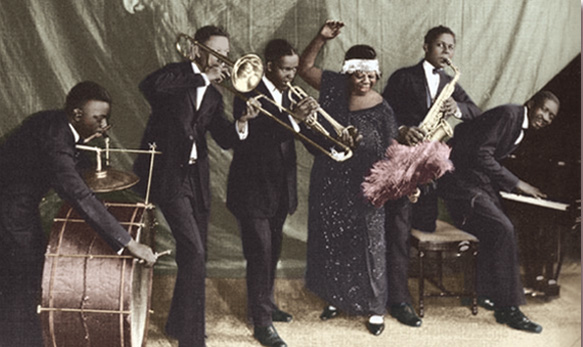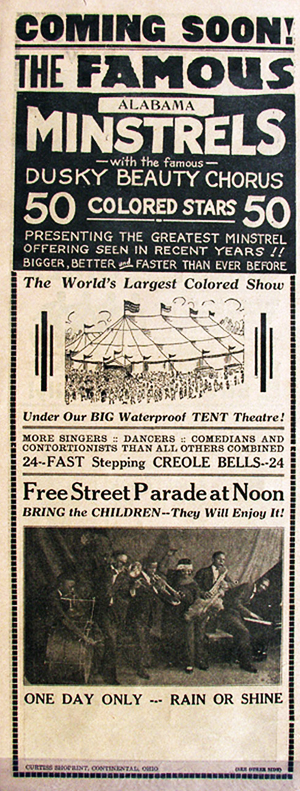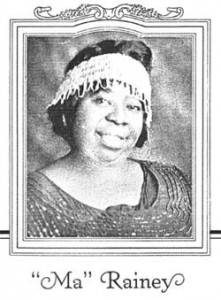
Ma Rainey and her band, 1923 Photo courtesy redhotjazz.
Long before Mamie Smith had the first hit recording of the blues in 1921, blues shouters in traveling tent shows stirred things up across the South. Nothing could draw a crowd like the spectacle of Ma Rainey moaning the blues on a hot summer night.

Tent show ad featuring Ma Rainey and the Alabama Minstrels. Courtesy bluesimages.
Following the harvests throughout the South, tent shows brought vaudeville to black audiences along dusty back roads. Out of lumber camps and river settlements, the working-class poor traveled by foot or packed into train cars for the thrill of seeing live entertainment.
Under a canvas big top, beneath a southern moon in the early decades of the 20th century, blues shouters belted out songs like "He May Be Your Man but He Comes to See Me Sometimes." Blues Queens were the stars of traveling troupes like the Georgia Smart Set, Tolliver’s Circus and Musical Extravaganza, and Ma Rainey's Rabbit Foot Minstrels. A typical tent show included a hot rhythm band, chorus dancers, comedy sketches, acrobats, animal acts and sometimes sideshows. The headliners were "black pearls," Blues Queens, covered in rhinestones and bugle beads, who closed the show with a star turn, shouting the blues. The biggest stars of them all were "the gold throat mamas"—Ma Rainey and her protégé Bessie Smith.
The blues numbers Ma Rainey sang weren't only about lost love and sexual innuendo. She sang the blues about devastating floods, a blight on the crops, being broke or going to prison.
As the blues migrated to big cities in the North and became popular with mainstream audiences, no one kept more closely to the themes of Ma Rainey's country blues than Victoria Spivey. In 1929 Spivey had a hit with a chilling number called "Dirty T.B. Blues."
Ma Rainey never achieved the mainstream success of younger blues shouters Alberta Hunter, Bessie Smith or Ida Cox. But Rainey was immortalized in a piece published in 1932 by Harlem Renaissance poet Sterling Brown, excerpted here:
"When Ma Rainey comes to town
Folks from anyplace, miles aroun'
From Cape Giradeau to Poplar Bluff,
Flocks in to hear Ma do her stuff;
Comes flivverin' in, or ridin' mules,
Or packed in trains, picknickin' fools...
That's what it's like fo' miles on down,
To the New Orleans delta an' Mobile town,
When Ma hits anywheres aroun'."
This week on Riverwalk Jazz, actor Vernel Bagneris and singer Topsy Chapman join The Jim Cullum Jazz Band in a tribute to Ma Rainey, her Rabbit Foot Minstrels and blues shouters of the Deep South in the 1920s.
Photo credit for Home Page: Ma Rainey. Photo courtesy gmh.us
Text based on Riverwalk Jazz script ©2012 by Margaret Moos Pick



